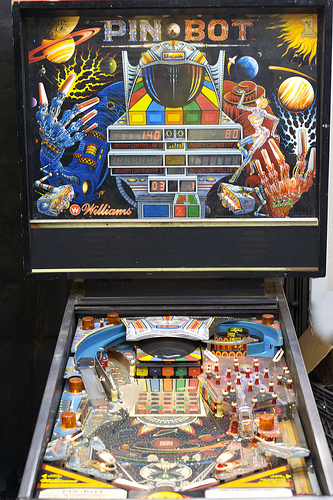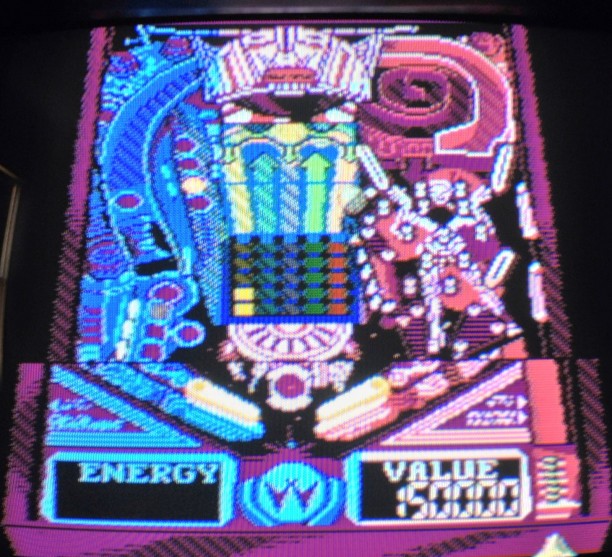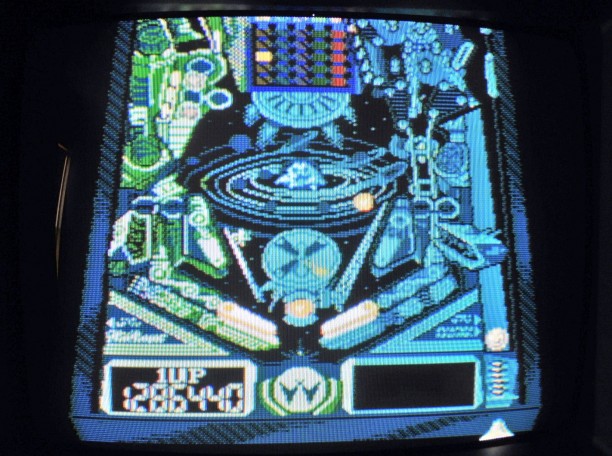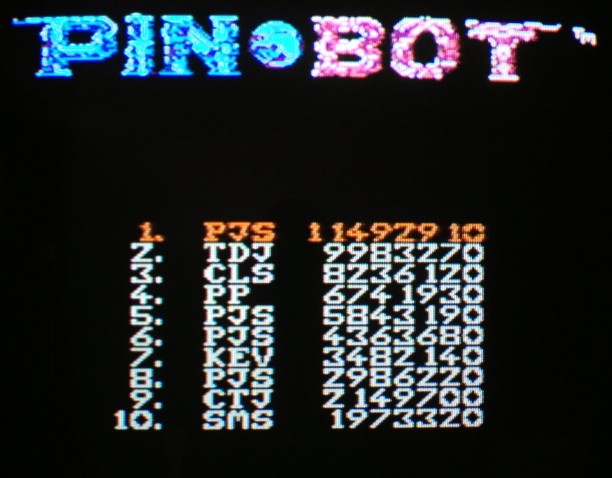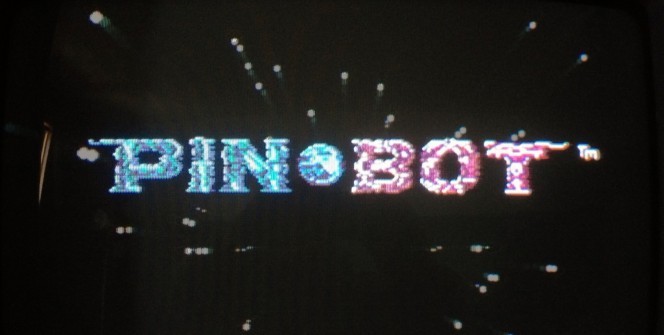
Pinball Alley
Pinball Alley: Pin*Bot
1987 feels forever ago. Walk Like an Egyptian was popular on the radio. Married With Children debuted on a relatively new television network that Fox had launched. The Iran-Contra affair was seemingly on everyone’s mind.
Me? I was a goofy 15 year-old high school sophomore and was still very much an arcade rat. I spent hours on weekends, and even a little time during the week, just walking around and watching people play, trying to decide what to spend my money on. The arcade that I frequented the most was in Chicopee, MA inside the Fairfield Mall, and the arcade was set up with coin-op machines in the front and two banks of pinball machines in the back. I spent a lot of time playing High Speed, which I’d become adept at (and also became an NES game, which I’ll be covering soon)… but one day, I spotted a new machine alongside it: Pin*Bot.
Pin*Bot never quite grew on me the way that High Speed did during 1987, but it had its share of cool features. The most notable was Pin*Bot’s visor, which would mechanically open up for ball locks after completing a bank of light targets. Two-ball multiball was the table’s main feature, which was easier to track and maintain than the three-ball mode in High Speed, and there was only one ramp of consequence that would come into play during multiball. It was easy to learn, difficult to master, and scoring was slightly down on average from High Speed. This was primarily due to the smaller jackpot (called Solar Value) limit, which capped at two million points as opposed to the four million point limit for the Hideout Jackpot in High Speed. I spent a fair number of tokens on Pin*Bot during 1987 and 1988 and wound up becoming reasonably skilled.
After getting my NES in late 1990, I happened to see that Nintendo had published a home version of Pin*Bot— and I just had to buy it. It felt reasonably close to the original, with some new additions to keep the experience interesting since no more tokens or quarters were required. I played it for hours, and it was my first NES pinball experience. I hadn’t played any of the other pinball titles at that time, so Pin*Bot was really my first impression of pinball on the platform. It was a good one.
The game still holds up today, quite honestly. While Farsight Studios delivered a much more realistic simulation of the table via Pinball Hall of Fame: The Williams Collection (X360, PS3, Wii, PS2) back in 2o09, the NES version maintains most of the same features and challenge that the original table offers, and the added wrinkles will keep even the most skilled players on their toes. Let’s dive in and take a look at what makes Pin*Bot tick:
Before launching the ball into play, careful players will try to judge how far to pull the plunger back, which is accomplished by holding the B button down. When the ball is launched in the spiral (called the Vortex, in the upper right), there are three scoring options: 5,000 points, 100,000 points, and 20,000 points. Judging how long to hold the B button down for the best results will take some practice, but it’s worthwhile in the long run. The Vortex value can be multiplied based on ball locks or hitting left ramp shots and having the ball wind up back in the plunger area. During a good ball, a 5x multiplier and a perfect Vortex skill shot can net half a million points, so it’s worth learning the timing.
Once the ball drops into one of the three Vortex scoring holes, it usually interacts with a trio of bumpers which increase a progressive bonus called the Energy Value before eventually working its way onto the main playfield. This is where strategy begins.
Just to the left of the Energy Value bumpers is a grid of lights. At first, the lights flash in straight lines which correspond to each of ten targets: five on Pin*Bot’s visor and five on a bank just to the left of the bumpers. All of the lights can be spotted simultaneously if players can time a shot to hit the corresponding target that starts the line of lights. For example, if there’s a vertical line, hit the target on Pin*Bot’s visor that matches where the line begins. If the line is horizontal, hit the target on the target bank just to the left of the Energy Value bumpers. Doing so lights the whole grid and Pin*Bot’s visor will rise, revealing two capture holes. If a player misses and hits the wrong target, only one light will spot and the grid will have to be completed bit by bit. This takes longer, but isn’t necessarily a bad strategy as each spotted light adds to the outhole bonus once the ball drains.
Before we get to what happens under the visor, it’s important to talk about the Solar Ramp, which is the only ramp in the game. It’s located at the upper left of the playfield and is a surprisingly difficult shot to hit with consistency. Each successful shot up this ramp increases the outhole bonus multiplier (up to 5x), adds 50,000 points to the Solar Value jackpot, and rolls the ball to a pachinko-style board positioned on top of the Energy Value bumpers. There are two outcomes to this mini-pachinko sequence: the ball either drains to the right-hand flipper outlane or it drains back into the plunger area, increasing the Vortex skill shot multiplier and allowing the player to attempt the skill shot again. (NOTE: This differs from the actual pinball table, as there’s actually a third outcome: The ball can fall through a hole in the middle of the mini-pachinko table, dropping into the Energy Value bumper area. The ball does not fall through that hole in the NES game.) It’s advisable to learn the timing to make this ramp shot with regularity; not only is worthwhile for adding to the jackpot and increasing the outhole multiplier, but it’s also the required shot for collecting the jackpot during multiball. The shot must be made using the right-hand flipper, shooting cross-table at an angle to hit the ramp. More often than not, players will find that they’re hitting the flipper too early to make this shot… so slightly more patience is necessary. This is a higher-pressure shot when shooting for the Solar Value and knowing that time is running out.
Multiball is triggered when both balls are locked in the capture holes revealed when Pin*Bot’s visor opens. The balls are locked one at a time, and it’s important to remember where the open capture hole is when one ball is locked. The timing for flipper shots to lock the balls is pretty easy, which is good. Once multiball begins, all scoring is doubled and a two-part objective awaits. First, one of the balls must be locked again. This is the easy part. After the ball is locked, the visor closes and the more daunting part of the objective remains: collecting the Solar Value by hitting the ramp shot before the visor opens again. Even if you’ve learned the timing, knowing that a jackpot awaits makes the shot tougher to hit because of what’s at stake and because of the race against time. Your heart beats a bit faster, your hands grip the controller a bit tighter, and making accurate shots becomes very challenging. Hitting that shot rewards the player with the Solar Value jackpot, the table changes colors, and the “next level” begins.
This is where the NES game diverges from the actual pinball table, and it’s arguably where pure pinball players begin to flip their lids.
Pin*Bot‘s “second level” features a blue monster than circles the Solar System in the lower center of the playfield. It moves from planet to planet, starting at Pluto (this was back when Pluto was still recognized as a planet) and it works its way towards the Sun in the center of the Solar System at random intervals. Once it reaches the Sun, look out. It becomes a vacuum cleaner, sucking the ball towards it when the ball is in close proximity. Sometimes the momentum of the ball is enough to break the vacuum and it only affects trajectory; however, if the ball is captured, the monster eats the ball and spits it out, effectively ending the player’s turn unless it’s during multiball. Tilting and nudging doesn’t work against the monster; it’s instant death and there’s not a thing that players can do about it. The “third level” replaces the monster with flying aliens that drop guided missiles towards one of the flippers. The missiles can be destroyed en route to the flipper if the ball hits them, but the missile cannot be flashing or else the ball will simply go through it. One missile hit on a flipper damages it, reducing its speed and reaction. A second hit completely destroys it, leaving the player one flipper short until the ball drains. For those lucky enough to reach the “fourth level”, a second type of flying alien comes into play that can capture the player’s ball and carry it off of the screen, ending the player’s turn. That’s as far as I’ve managed to advance. I shudder to think about what the “fifth level” might entail.
This level progression could adjust player strategy when aiming for the highest scores. My suggestion is to stay on the “first level” and not go after the Solar Value until it’s accumulated to at least one million points. It’s not necessarily worth the risk and added obstacles otherwise, as turns get shorter due to playfield perils. Keep in mind that the jackpot is progressive and will build to a maximum of two million points, even if it’s not collected during the course of one game. It’s possible to spend one game just hitting ramp shots and increasing the Solar Value, then dedicating the next game to collecting the large jackpot and catapulting the overall score into seven figures. It’s also possible to build score and collect extra balls in a couple of other ways.
The first way is by activating the capture hole which is nestled in the upper right of the table between the Solar Ramp and Pin*Bot’s visor. Each activation (by way of the right-hand flipper rollover) and successive capture hole shot increases the value of the hole. The first shot is worth 25,000 points, the second is worth 50,000 points, the third is worth 75,000 points, and the fourth spots the extra ball rollover light on the outlanes. Each shot thereafter is worth another 75,000 points. This shot is fairly easy to make, and the extra ball light can be shifted between outlanes with flips of the trigger… so grabbing the extra ball is easier. It’s a fairly easy shot to make consistently and is especially beneficial during multiball thanks to double scoring.
The second way is by advancing through the Solar System. Planets are spotted by doing one of the following:
- Hit all three drop targets on the bank just below and to the left of the Solar Value ramp
- Spot (via the left flipper outlane) and hit the nestled target just below and to the right of the Energy Value bumpers
Planets remain lit once they are completed, and when enough are lit, a Special is awarded. The Special is another extra ball opportunity. If a player manages to light all of the planets, including the Sun, another Special is awarded and the ball changes shape from spherical to a wedge-like appearance.
This means that at least three extra balls can be earned, in addition to the three that a player starts with. This is especially valuable as the levels change and is essential if any score over 10 million points is the goal. Some sacrificing may have to be done, especially on the second level with the ball-eating monster, in order to reset the obstacles and to give the best chance at collecting the jackpot and advancing to the next level.
RARE‘s design decisions with Pin*Bot— and later with High Speed— don’t fly with everyone. While Pin*Bot does a very good job of simulating the original Williams table and delivering a decent pinball experience, all bets are off once the level progressions begin and players are at the mercy of playfield perils. They alter gameplay strategy, and not necessarily in a good way. If I was giving advice on how to play the actual Pin*Bot table, I’d always tell players to collect Solar Values whenever possible. In this version, players must judge whether the reward is worth the risk… especially when going from the initial level to the second. Once levels advance, pinball skill is de-emphasized and luck takes over. That takes away from the overall experience, which is unfortunate. I do understand why the progressive design was implemented, but I’ve never agreed with its execution and still don’t to this day.
For beginning players, Pin*Bot is a good table to learn the basics of multiball play and it isn’t weighed down by too many objectives to understand. Learning proper shot timing will be key, but this table doesn’t use back-door (inside of the hinge of the flipper) shots for much because it’s relatively narrow. Intermediate and experienced players will have no problem picking this game up and should score somewhere between 4-5 million points before long. These players may also notice some inconsistency with the ball physics in the game, especially when bouncing towards the outlanes or shots that don’t look like they’re lined up for the ramp but manage to hit anyway, but this physics model tends to reward skilled players rather than penalize skill for luck.
Despite my gripes with level progression, Pin*Bot is still a generally enjoyable pinball game and succeeds in bringing the arcade experience home. The graphics represent the original table well, the music is excellent, and the voice clips add authenticity. It’s not quite the same as having the machine in your living room, and better simulations do exist currently, but if the NES is your retro platform of choice, Pin*Bot deserves a spot in your cartridge rack.
